Coyoacan, Mexico City, is a vibrant and historic neighborhood that offers a plethora of attractions and activities, especially for LGBTQ+ travelers looking for a welcoming and culturally rich experience. This guide, brought to you by gaymexico.net, dives into the best things to do in Coyoacan, from exploring Frida Kahlo’s iconic Casa Azul to discovering hidden gems in its charming streets, ensuring an unforgettable journey filled with queer-friendly spots and unforgettable memories. Ready to explore Coyoacan?
1. Discovering Casa Azul: Frida Kahlo’s Life and Art
Casa Azul, also known as the Frida Kahlo Museum, is a must-visit destination in Coyoacan, Mexico City, offering a deep dive into the life, art, and spirit of one of Mexico’s most iconic artists. This historical home, where Frida Kahlo was born, lived, and eventually passed away, provides an intimate glimpse into her world, showcasing her artwork, personal belongings, and the unique atmosphere that fueled her creativity.
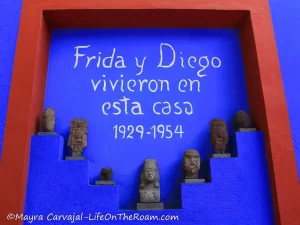 A blue wall with pre-Hispanic figurines and the text
A blue wall with pre-Hispanic figurines and the text
1.1 What makes Casa Azul so special?
Casa Azul is special because it was Frida Kahlo’s birthplace, home, and eventual place of death, offering a unique and intimate glimpse into her life, her artistic process, and her personal struggles, making it an essential destination for anyone interested in art, history, and Mexican culture. The museum showcases Kahlo’s artwork, personal belongings, and the unique atmosphere that fueled her creativity, making it a deeply personal and moving experience.
The vibrant blue walls, the lush courtyard, and the carefully preserved rooms offer a tangible connection to Frida Kahlo’s world, allowing visitors to step back in time and experience the environment that shaped her artistic vision. According to research from the Museo Frida Kahlo, Casa Azul attracts visitors from around the globe, all eager to pay homage to this influential artist.
1.2 What can visitors expect to see at Casa Azul?
Visitors to Casa Azul can expect to see a diverse collection of Frida Kahlo’s artwork, including original portraits, sketches, and lesser-known pieces that provide insight into her artistic range and creative process. Beyond her art, the museum also houses a variety of personal items, such as her clothing, jewelry, and medical equipment, which offer a glimpse into her daily life and the challenges she faced.
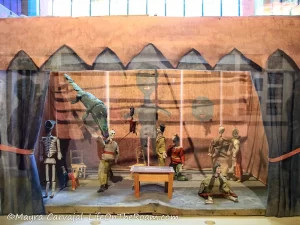 A puppet theatre
A puppet theatre
The museum also showcases a collection of folk art, pre-Columbian artifacts, and photographs, reflecting Kahlo’s deep appreciation for Mexican culture and her connections to the art world. The beautifully maintained courtyard, with its lush plants and tranquil atmosphere, provides a peaceful space for reflection and appreciation of the artist’s life and legacy.
1.3 How does Casa Azul reflect Frida Kahlo’s LGBTQ+ identity?
Casa Azul reflects Frida Kahlo’s LGBTQ+ identity through the celebration of her unconventional lifestyle, her challenges to societal norms, and her representation as a queer icon. According to an article by Art News in June 2023, Kahlo’s open relationships and gender-fluid fashion choices are highlighted, underscoring her role as a pioneer of LGBTQ+ expression.
The museum’s displays include photographs and personal effects that hint at her relationships with women, reflecting her bisexuality and her embrace of diverse forms of love and connection. Casa Azul also showcases Kahlo’s unique sense of style, which often blurred traditional gender lines, further emphasizing her non-conformist attitude and her commitment to living authentically.
1.4 What are some must-see rooms or exhibits in Casa Azul?
Some must-see rooms and exhibits in Casa Azul include Frida Kahlo’s studio, which remains as she left it, complete with her wheelchair, easel, and art supplies, offering a personal glimpse into her creative process. The kitchen, with its vibrant colors and traditional Mexican decor, provides a sense of the domestic life she shared with Diego Rivera, showcasing their love for Mexican culture and cuisine.
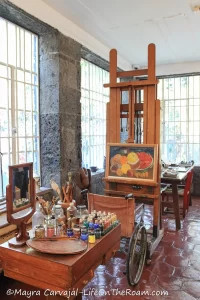 A sunlit room with a wheelchair, an easel, and art supplies
A sunlit room with a wheelchair, an easel, and art supplies
The bedrooms, adorned with her personal mementos, medical devices, and gifts from friends, offer an intimate look into her daily life and struggles with health. The courtyard, with its lush greenery, pre-Columbian artifacts, and tranquil atmosphere, provides a serene space for reflection and appreciation of Kahlo’s connection to nature and Mexican heritage.
1.5 How can visitors purchase tickets and plan their visit to Casa Azul?
Visitors can purchase tickets to Casa Azul online in advance, which is highly recommended due to the museum’s popularity and limited capacity. Tickets are available on the official Museo Frida Kahlo website. According to the Museo Frida Kahlo official website, it is recommended to book tickets at least two weeks in advance to secure your preferred date and time.
Planning the visit involves selecting a specific date and time slot, arriving promptly to avoid long lines, and allowing ample time to explore the museum’s exhibits and grounds. The museum is open from Tuesday to Sunday, with varying hours depending on the day, so it’s essential to check the schedule before planning your visit.
1.6 What are some tips for making the most of a visit to Casa Azul?
To make the most of a visit to Casa Azul, arrive early or during off-peak hours to avoid crowds and fully appreciate the intimate atmosphere of the museum. Take your time to explore each room and exhibit, paying attention to the details and personal touches that offer insight into Frida Kahlo’s life and art.
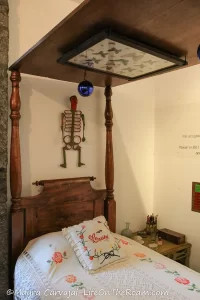 A canopy bed with framed butterflies on the top part
A canopy bed with framed butterflies on the top part
Consider joining a guided tour to learn more about Kahlo’s life, her artistic techniques, and the cultural context in which she worked. Wear comfortable shoes, as you’ll be doing a fair amount of walking, and bring a camera to capture the vibrant colors and unique details of the museum.
1.7 Are there any LGBTQ+-specific events or tours at Casa Azul?
While Casa Azul may not have regularly scheduled LGBTQ+-specific events or tours, the museum’s celebration of Frida Kahlo’s life and legacy often resonates with the LGBTQ+ community due to her non-conformist spirit and embrace of diverse identities. According to a blog post from Gay Mexico Journey in May 2024, visitors can explore the museum through the lens of Kahlo’s queer identity and her impact on LGBTQ+ culture.
Visitors can also check the museum’s official website or social media channels for any special events or exhibitions that may be of particular interest to the LGBTQ+ community. Additionally, private tour operators may offer customized tours that focus on Kahlo’s queer identity and her contributions to LGBTQ+ visibility in art and culture.
2. Discovering the Spiritual Heart of Coyoacan: San Juan Bautista Church
The Church of San Juan Bautista, also known as St. John the Baptist Church, is a prominent religious landmark in Coyoacan, Mexico City, known for its historical significance, architectural beauty, and cultural importance. This 16th-century church, located in the heart of Coyoacan, offers visitors a glimpse into the region’s rich religious heritage and artistic traditions.
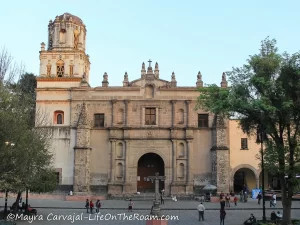 The stone façade of a church
The stone façade of a church
2.1 What is the historical significance of the Church of San Juan Bautista?
The Church of San Juan Bautista holds immense historical significance as one of the oldest churches in Mexico City, dating back to the early colonial period. Built in the 16th century by Franciscan missionaries, the church played a crucial role in the evangelization of the indigenous population and the establishment of Christianity in the region. According to historical records from the National Institute of Anthropology and History (INAH), the church served as a center for religious instruction, community gatherings, and cultural exchange.
Over the centuries, the Church of San Juan Bautista has witnessed significant events in Mexican history, including periods of political upheaval, social change, and cultural transformation. Its enduring presence in Coyoacan serves as a reminder of the region’s complex and layered past.
2.2 What architectural features make the church unique?
The Church of San Juan Bautista boasts a unique blend of architectural styles, reflecting its long history and diverse cultural influences. The church’s facade features a combination of Baroque and Neoclassical elements, with intricate carvings, ornate sculptures, and towering bell towers. According to architectural studies from the Universidad Nacional Autónoma de México (UNAM), the church’s interior is equally impressive, with soaring arches, gilded altars, and elaborate frescoes depicting scenes from the Bible.
The church’s central nave is adorned with stained glass windows that cast colorful patterns of light across the space, creating a serene and contemplative atmosphere. The church also features a series of side chapels, each dedicated to a different saint and decorated with unique works of art.
2.3 What can visitors see inside the Church of San Juan Bautista?
Inside the Church of San Juan Bautista, visitors can admire a wealth of religious art, historical artifacts, and architectural details that reflect the church’s rich cultural heritage. The church’s main altar is a masterpiece of Baroque craftsmanship, with intricate carvings, gilded accents, and a statue of St. John the Baptist, the church’s patron saint.
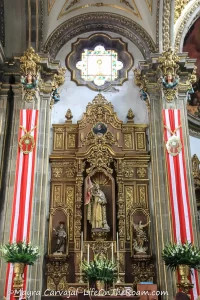 An ornate wood altar with Catholic religious figures
An ornate wood altar with Catholic religious figures
The church’s walls are adorned with paintings, sculptures, and frescoes depicting scenes from the Bible, as well as portraits of important religious figures. The church also houses a collection of historical documents, religious relics, and liturgical objects that offer insights into the church’s past and its role in the community.
2.4 Are there any LGBTQ+-specific aspects or connections to the church?
While the Church of San Juan Bautista may not have explicit LGBTQ+-specific aspects or connections, some members of the LGBTQ+ community may find solace and inspiration in the church’s message of love, compassion, and acceptance. According to LGBTQ+ religious organizations, some progressive churches within the Catholic tradition have begun to embrace LGBTQ+ individuals and advocate for their inclusion in religious life.
Additionally, the church’s historical significance and artistic beauty may resonate with LGBTQ+ visitors who appreciate cultural heritage and creative expression. The church’s central location in Coyoacan, a neighborhood known for its LGBTQ+-friendly atmosphere, may also make it a welcoming space for LGBTQ+ individuals seeking spiritual enrichment.
2.5 How can visitors attend mass or other religious services at the church?
Visitors can attend mass or other religious services at the Church of San Juan Bautista by checking the church’s official schedule or inquiring at the parish office. Mass is typically celebrated on Sundays and weekdays, with varying times depending on the day and season. According to the church’s website, visitors are welcome to attend mass regardless of their religious affiliation or background.
When attending mass, visitors are expected to dress respectfully and observe the church’s rules of conduct, which may include refraining from talking loudly, taking photographs, or wearing revealing clothing. Visitors may also participate in religious rituals, such as receiving communion or making offerings, according to their personal beliefs and practices.
2.6 What are some nearby attractions or landmarks to visit after the church?
After visiting the Church of San Juan Bautista, visitors can explore other nearby attractions and landmarks in Coyoacan, such as the Plaza Hidalgo, the Jardin Centenario, and the Frida Kahlo Museum. The Plaza Hidalgo, located adjacent to the church, is a lively public square that hosts cultural events, street performances, and artisan markets.
The Jardin Centenario, a nearby park, features a beautiful fountain, lush gardens, and a charming gazebo. The Frida Kahlo Museum, a short walk from the church, offers a fascinating glimpse into the life and art of the iconic Mexican painter.
3. Experiencing the Heart of Coyoacan: Plaza Hidalgo and Jardin Centenario
Plaza Hidalgo and Jardin Centenario serve as the vibrant heart of Coyoacan, Mexico City, offering a captivating blend of history, culture, and community life. These two interconnected squares, located in the center of Coyoacan, provide a welcoming space for locals and tourists alike to gather, relax, and immerse themselves in the neighborhood’s unique atmosphere.
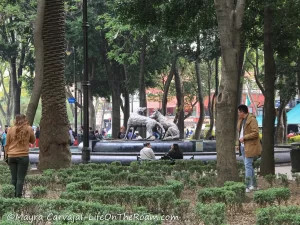 A park with mature trees and a fountain
A park with mature trees and a fountain
3.1 What makes Plaza Hidalgo and Jardin Centenario the heart of Coyoacan?
Plaza Hidalgo and Jardin Centenario are considered the heart of Coyoacan due to their central location, historical significance, and role as gathering places for the community. Plaza Hidalgo, named after Mexican independence hero Miguel Hidalgo, has been a focal point of Coyoacan since the colonial era, hosting important events, religious celebrations, and political rallies. According to historical accounts from the Coyoacan municipal archives, the plaza has served as a meeting place for residents, a venue for cultural performances, and a symbol of local identity.
Jardin Centenario, which translates to Centennial Garden, was established in the late 19th century to commemorate the centennial of Mexican independence. The garden features lush greenery, a beautiful fountain, and a charming gazebo, providing a tranquil space for relaxation and recreation.
3.2 What are some notable features of Plaza Hidalgo?
Plaza Hidalgo boasts several notable features that contribute to its charm and historical significance. The plaza is anchored by a majestic monument dedicated to Miguel Hidalgo, the priest who sparked the Mexican War of Independence in 1810. According to historical records from the National Institute of Anthropology and History (INAH), the monument serves as a symbol of Mexican patriotism and a reminder of the country’s struggle for independence.
The plaza is also surrounded by colonial-era buildings, including the Church of San Juan Bautista, the Coyoacan Municipal Palace, and several historic homes. These buildings feature intricate architectural details, such as ornate facades, wrought-iron balconies, and colorful tile work, reflecting the neighborhood’s rich cultural heritage.
3.3 What can visitors see and do in Jardin Centenario?
Visitors to Jardin Centenario can enjoy a variety of activities and attractions in this lush and inviting park. The garden’s centerpiece is the Fuente de Los Coyotes, a beautiful fountain adorned with sculptures of coyotes, the animal that gives Coyoacan its name. According to local legend, the coyotes symbolize wisdom, strength, and cunning, reflecting the spirit of the neighborhood.
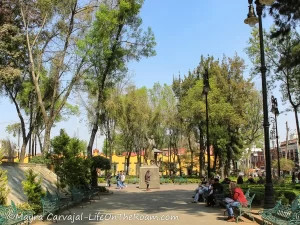 A monument of a national hero in a square with trees and benches
A monument of a national hero in a square with trees and benches
Visitors can also stroll along the garden’s winding paths, admire the colorful flowers and lush greenery, and relax on one of the many benches scattered throughout the park. The garden is also a popular spot for cultural events, such as concerts, dance performances, and artisan markets.
3.4 Are there any LGBTQ+-friendly establishments or events near the squares?
While Plaza Hidalgo and Jardin Centenario may not host LGBTQ+-specific events, the surrounding area of Coyoacan is known for its LGBTQ+-friendly atmosphere, with several establishments that cater to the community. According to local LGBTQ+ organizations, Coyoacan is home to a number of gay-friendly bars, cafes, and restaurants that welcome LGBTQ+ patrons and allies.
Additionally, the neighborhood hosts occasional LGBTQ+ cultural events, such as film screenings, art exhibitions, and community gatherings. Visitors can check local listings or consult with LGBTQ+ organizations for information on upcoming events and activities.
3.5 How do locals use and enjoy these public spaces?
Locals use and enjoy Plaza Hidalgo and Jardin Centenario as gathering places for socializing, relaxing, and participating in community life. On weekends, the squares are filled with families, couples, and groups of friends who come to enjoy the lively atmosphere, listen to music, and watch street performers. According to local residents, the squares serve as a vital part of Coyoacan’s social fabric, providing a space for people of all ages and backgrounds to come together and connect.
The squares are also used for cultural events, such as concerts, dance performances, and artisan markets, which showcase the neighborhood’s rich artistic heritage. During holidays and festivals, the squares are decorated with colorful banners, lights, and decorations, creating a festive atmosphere that reflects the community’s spirit of celebration.
3.6 What are some tips for visiting Plaza Hidalgo and Jardin Centenario?
To make the most of a visit to Plaza Hidalgo and Jardin Centenario, plan to spend some time exploring both squares and soaking up the atmosphere. Arrive early in the morning or late in the afternoon to avoid the crowds and enjoy the squares’ tranquility. Wear comfortable shoes, as you’ll be doing a fair amount of walking, and bring a hat and sunscreen to protect yourself from the sun.
Take some time to admire the architectural details of the surrounding buildings, and be sure to visit the Church of San Juan Bautista, which is located on Plaza Hidalgo. Sample some of the local cuisine at the nearby restaurants and cafes, and browse the artisan markets for unique souvenirs.
4. Satisfy Your Sweet Tooth: Churrería General de La República
Churrería General de La República is a beloved institution in Coyoacan, Mexico City, known for its delicious churros and traditional Mexican sweets. This charming churrería, located just steps away from the Jardin Centenario, offers a delightful culinary experience for visitors seeking a taste of authentic Mexican flavors.
4.1 What makes Churrería General de La República a must-visit?
Churrería General de La República is a must-visit due to its long-standing tradition of serving high-quality churros made with fresh ingredients and time-honored recipes. According to local food critics, the churrería’s churros are renowned for their crispy exterior, soft interior, and delectable flavor. The churrería’s central location in Coyoacan, combined with its reputation for excellence, makes it a popular destination for locals and tourists alike.
The churrería also offers a variety of traditional Mexican sweets, such as dulce de leche, cajeta, and chocolate, providing a diverse range of flavors to satisfy any sweet tooth. The churrería’s charming atmosphere, with its colorful decor and friendly staff, adds to the overall experience, creating a warm and welcoming environment for visitors.
4.2 What types of churros and other sweets are available?
Churrería General de La República offers a wide variety of churros, including traditional churros coated in sugar or cinnamon, as well as churros filled with chocolate, dulce de leche, cajeta, or fruit preserves. According to the churrería’s menu, the churros are made fresh throughout the day, ensuring that each one is crispy, warm, and delicious. The churrería also offers a selection of traditional Mexican sweets, such as dulce de leche, a creamy caramel-like confection, cajeta, a sweet made from goat’s milk, and chocolate, a rich and flavorful treat.
Visitors can also enjoy a variety of beverages, such as café de olla, a traditional Mexican coffee brewed with cinnamon and piloncillo, and atole, a thick and creamy drink made from cornmeal, cinnamon, and sugar.
4.3 Are there any vegan or gluten-free options available?
Unfortunately, Churrería General de La República does not currently offer vegan or gluten-free options. According to the churrería’s staff, the churros are made with wheat flour and eggs, and the fillings contain dairy products. However, visitors with dietary restrictions may be able to find suitable options at nearby cafes or restaurants that cater to vegan or gluten-free diets.
Visitors with dietary restrictions are encouraged to inquire with the churrería’s staff about the ingredients used in their products and to check local listings for alternative options.
4.4 What is the ambiance like at Churrería General de La República?
The ambiance at Churrería General de La República is warm, inviting, and reminiscent of old-world Mexican charm. The churrería’s decor features colorful walls, traditional tile work, and vintage photographs, creating a cozy and nostalgic atmosphere. According to visitors, the churrería’s friendly staff adds to the overall experience, providing excellent service and making customers feel welcome.
The churrería’s central location in Coyoacan, just steps away from the Jardin Centenario, makes it a convenient and popular spot for locals and tourists alike. The churrería is often bustling with activity, creating a lively and festive atmosphere that reflects the spirit of Coyoacan.
4.5 How can visitors find and get to Churrería General de La República?
Churrería General de La República is located at a convenient address in Coyoacan, just steps away from the Jardin Centenario. The churrería’s address is easily found online through search engines or online maps. According to online reviews, the churrería is easily accessible by public transportation, taxi, or ride-sharing services.
Visitors can also reach the churrería by walking from other popular attractions in Coyoacan, such as the Frida Kahlo Museum or the Church of San Juan Bautista. The churrería’s central location and well-known reputation make it a landmark in Coyoacan, easily recognizable and accessible to visitors.
4.6 What are some other nearby dessert or snack options in Coyoacan?
In addition to Churrería General de La República, Coyoacan offers a variety of other dessert and snack options to satisfy any craving. Helados Siberia, located next to Jardin Centenario, offers a wide range of ice cream and sorbet flavors, while the Coyoacan Market is home to numerous stalls selling traditional Mexican sweets, fresh fruits, and savory snacks.
Visitors can also find a variety of cafes, bakeries, and restaurants in Coyoacan that offer desserts, pastries, and other sweet treats. Coyoacan’s diverse culinary scene ensures that visitors will find something to satisfy their sweet tooth.
5. Cool Down with a Sweet Treat: Helados Siberia
Helados Siberia is a beloved ice cream shop in Coyoacan, Mexico City, known for its wide variety of unique and delicious ice cream flavors. Conveniently located next to the Jardin Centenario, this ice cream shop offers a refreshing treat for visitors exploring the neighborhood’s attractions.
5.1 What makes Helados Siberia a popular ice cream destination?
Helados Siberia is a popular ice cream destination due to its long-standing tradition of serving high-quality ice cream made with fresh ingredients and innovative flavor combinations. According to local food bloggers, the ice cream shop is renowned for its creamy texture, intense flavors, and diverse selection of both traditional and exotic options. The ice cream shop’s central location in Coyoacan, combined with its reputation for excellence, makes it a favorite among locals and tourists alike.
The ice cream shop also offers a variety of sorbets and frozen treats, providing options for those seeking dairy-free or lighter alternatives. The ice cream shop’s charming atmosphere, with its colorful decor and friendly staff, adds to the overall experience, creating a warm and welcoming environment for visitors.
5.2 What are some unique or must-try ice cream flavors?
Helados Siberia offers a variety of unique and must-try ice cream flavors that showcase the creativity and culinary expertise of the ice cream shop. One popular flavor is Beso de Angel (Angel’s Kiss), a combination of mammee, pecans, and strawberry that offers a delightful blend of sweet and nutty flavors. According to the ice cream shop’s menu, this flavor is a customer favorite and a must-try for first-time visitors.
Another unique flavor is cheese ice cream, a savory and surprisingly delicious option that combines the creamy texture of ice cream with the tangy flavor of cheese. The ice cream shop also offers a variety of traditional Mexican flavors, such as cajeta (goat milk candy), horchata (rice milk), and tamarindo (tamarind), providing a taste of authentic Mexican cuisine.
5.3 Are there dairy-free or vegan options available?
Yes, Helados Siberia offers dairy-free and vegan options in the form of sorbets. According to the ice cream shop’s staff, the sorbets are made with fresh fruits, water, and sugar, and do not contain any dairy products or animal-derived ingredients. The sorbets come in a variety of flavors, such as mango, strawberry, and lime, providing refreshing and flavorful options for visitors with dietary restrictions.
Visitors with dietary restrictions are encouraged to inquire with the ice cream shop’s staff about the ingredients used in their products and to check local listings for alternative options.
5.4 What is the atmosphere like at Helados Siberia?
The atmosphere at Helados Siberia is vibrant, cheerful, and reminiscent of a classic ice cream parlor. The ice cream shop’s decor features colorful walls, vintage signage, and a display case filled with tempting ice cream flavors, creating a fun and inviting environment. According to visitors, the ice cream shop’s friendly staff adds to the overall experience, providing excellent service and making customers feel welcome.
The ice cream shop’s central location in Coyoacan, next to the Jardin Centenario, makes it a popular spot for locals and tourists alike. The ice cream shop is often bustling with activity, creating a lively and festive atmosphere that reflects the spirit of Coyoacan.
5.5 How can visitors find and get to Helados Siberia?
Helados Siberia is located at a convenient address in Coyoacan, next to the Jardin Centenario. The ice cream shop’s address is easily found online through search engines or online maps. According to online reviews, the ice cream shop is easily accessible by public transportation, taxi, or ride-sharing services.
Visitors can also reach the ice cream shop by walking from other popular attractions in Coyoacan, such as the Frida Kahlo Museum or the Church of San Juan Bautista. The ice cream shop’s central location and well-known reputation make it a landmark in Coyoacan, easily recognizable and accessible to visitors.
5.6 Are there other ice cream or dessert places nearby?
Yes, in addition to Helados Siberia, Coyoacan offers a variety of other ice cream and dessert options to satisfy any craving. Churrería General de La República, located nearby, is known for its delicious churros and traditional Mexican sweets, while the Coyoacan Market is home to numerous stalls selling traditional Mexican sweets, fresh fruits, and savory snacks.
Visitors can also find a variety of cafes, bakeries, and restaurants in Coyoacan that offer desserts, pastries, and other sweet treats. Coyoacan’s diverse culinary scene ensures that visitors will find something to satisfy their sweet tooth.
6. Immerse Yourself in Local Culture: Coyoacan Market
The Coyoacan Market, also known as Mercado de Coyoacan, is a bustling hub of local culture, cuisine, and commerce in Coyoacan, Mexico City. This vibrant market offers visitors an authentic glimpse into the daily lives of Coyoacan residents, as well as a chance to sample traditional Mexican food, shop for unique handicrafts, and experience the neighborhood’s lively atmosphere.
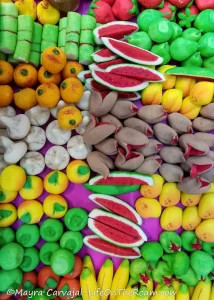 Colourful sweets in the shape of fruits
Colourful sweets in the shape of fruits
6.1 What makes the Coyoacan Market a cultural experience?
The Coyoacan Market is a cultural experience because it provides a window into the traditions, customs, and values of the Coyoacan community. According to local historians, the market has been a center of commerce and social interaction for centuries, serving as a gathering place for residents to buy, sell, and exchange goods, as well as to socialize and celebrate. The market’s stalls are filled with a variety of products that reflect the region’s cultural heritage, such as traditional Mexican clothing, handmade crafts, and regional cuisine.
The market’s vendors, many of whom are local artisans and farmers, take pride in their products and are eager to share their knowledge and stories with visitors. The market’s atmosphere is lively and festive, with music, laughter, and the aroma of delicious food filling the air.
6.2 What types of goods and products can visitors find at the market?
Visitors to the Coyoacan Market can find a wide variety of goods and products, including fresh fruits and vegetables, meats and seafood, prepared foods, clothing, shoes, handicrafts, souvenirs, and household items. According to the market’s vendors, the products are sourced from local farms, workshops, and suppliers, ensuring that they are fresh, authentic, and of high quality. The market’s selection of prepared foods is particularly impressive, with stalls offering everything from tacos and quesadillas to enchiladas and mole.
Visitors can also find a variety of traditional Mexican sweets, such as dulce de leche, cajeta, and churros, as well as refreshing beverages, such as agua fresca and horchata.
6.3 Are there any LGBTQ+-specific vendors or products at the market?
While the Coyoacan Market may not have specific LGBTQ+-themed vendors or products, LGBTQ+ visitors are likely to find a welcoming and inclusive atmosphere at the market. According to local LGBTQ+ organizations, Coyoacan is known for its LGBTQ+-friendly environment, and the market is a reflection of this inclusivity. LGBTQ+ visitors may find vendors selling products that celebrate diversity, promote equality, or express support for the LGBTQ+ community.
Visitors can also find vendors who are LGBTQ+ themselves or who are allies of the LGBTQ+ community, providing opportunities for connection and support. The market’s diverse and vibrant atmosphere makes it a welcoming space for people of all backgrounds and identities.
6.4 What are some popular food stalls or dishes to try at the market?
The Coyoacan Market is home to numerous popular food stalls and dishes that offer a taste of authentic Mexican cuisine. One must-try dish is the tostadas de Coyoacan, crispy tortillas topped with a variety of ingredients, such as beans, cheese, avocado, and salsa. According to local food bloggers, these tostadas are a market specialty and a must-try for visitors. Another popular dish is the quesadillas, grilled tortillas filled with cheese and other ingredients, such as mushrooms, squash blossoms, or huitlacoche (corn fungus).
Visitors can also try the mole, a rich and complex sauce made from chilies, spices, and chocolate, or the enchiladas, tortillas filled with meat or cheese and covered in sauce. The market also offers a variety of refreshing beverages, such as agua fresca, a fruit-flavored water, and horchata, a rice milk drink.
6.5 How can visitors navigate and make the most of their time at the market?
To navigate and make the most of their time at the Coyoacan Market, visitors should plan to spend several hours exploring the market’s numerous stalls and alleys. Wear comfortable shoes, as you’ll be doing a lot of walking, and bring a hat and sunscreen to protect yourself from the sun. Bring cash, as many of the vendors do not accept credit cards, and be prepared to haggle for the best prices.
Sample the local cuisine at the market’s food stalls, and be sure to try some of the market’s specialty dishes. Talk to the vendors, learn about their products, and ask for recommendations. Take your time, soak up the atmosphere, and enjoy the experience.
6.6 Are there any safety concerns or tips for visitors at the market?
While the Coyoacan Market is generally safe for visitors, it’s important to be aware of your surroundings and take precautions to protect yourself from crime. Be aware of pickpockets, and keep your valuables in a safe place. Avoid wearing expensive jewelry or carrying large amounts of cash. Be cautious when walking through crowded areas, and be aware of your surroundings.
If you’re approached by someone offering assistance or trying to sell you something, be polite but firm in your refusal. If you feel threatened or uncomfortable, leave the area and seek assistance from a market vendor or security guard. By taking these precautions, you can ensure a safe and enjoyable visit to the Coyoacan Market.
7. Get an Overview of Coyoacan: Turibús Circuito Sur Coyoacan
The Turibús Circuito Sur Coyoacan is a hop-on-hop-off tour bus that provides an overview of Coyoacan, Mexico City, allowing visitors to see the neighborhood’s top attractions and landmarks in a convenient and efficient manner. This tour is a good option for those who have limited time, prefer not to walk long distances, or want to learn about Coyoacan’s history and culture from an audio guide.
7.1 What is the Turibús Circuito Sur Coyoacan and how does it work?
The Turibús Circuito Sur Coyoacan is a hop-on-hop-off tour bus that follows a designated route through Coyoacan, stopping at the neighborhood’s most popular attractions and landmarks. The bus operates on a fixed schedule, and visitors can purchase a day pass that allows them to hop on and off the bus at any of the designated stops.
According to the Turibús website, the tour includes an audio guide in multiple languages that provides information about Coyoacan’s history, culture, and attractions. The tour is a convenient and efficient way to see Coyoacan’s top sights, and it allows visitors to customize their itinerary and explore the attractions that interest them most.
7.2 What sights and attractions are included on the tour route?
The Turibús Circuito Sur Coyoacan tour route includes several of Coyoacan’s top sights and attractions, such as the Frida Kahlo Museum, the Jardin Centenario, the Coyoacan Market, and the Church of San Juan Bautista. According to the Turibús website, the tour also passes by other notable landmarks, such as the UNAM (National Autonomous University of Mexico) and the Anahuacalli Museum.
The tour provides a comprehensive overview of Coyoacan’s history, culture, and architecture, and it allows visitors to see the neighborhood’s top sights in a convenient and efficient manner.
7.3 How long does the tour take and what is the frequency of buses?
The Turibús Circuito Sur Coyoacan tour takes approximately two hours to complete from the starting point at Cibeles Fountain in Roma Norte. According to the Turibús website, the buses run at regular intervals, typically every 30 to 60 minutes, depending on traffic conditions.
Visitors can purchase a day pass that allows them to hop on and off the bus at any of the designated stops, and they can ride the bus as many times as they like during the day. The tour is a flexible and convenient way to explore Coyoacan, and it allows visitors to customize their itinerary and explore the attractions that interest them most.
7.4 How much does the tour cost and where can visitors purchase tickets?
The Turibús Circuito Sur Coyoacan tour costs MXN$150 per person. According to the Turibús website, tickets can be purchased online, at the Turibús ticket office, or from the bus driver.
Visitors can purchase a day pass that allows them to hop on and off the bus at any of the designated stops, and they can ride the bus as many times as they like during the day. The tour is a flexible and convenient way to explore Coyoacan, and it allows visitors to customize their itinerary and explore the attractions that interest them most.
7.5 Are there any discounts or special offers available for the tour?
Yes, Turibús offers discounts and special offers for students, seniors, and groups. According to the Turibús website, students and seniors can receive a discount on the tour price by presenting a valid ID. Groups of 10 or more people can also receive a discount on the tour price.
Visitors can check the Turibús website or inquire at the Turibús ticket office for information on current discounts and special offers. Taking advantage of these discounts can make the tour even more affordable and accessible.
7.6 What are some pros and cons of taking the Turibús tour in Coyoacan?
Taking the Turibús tour in Coyo